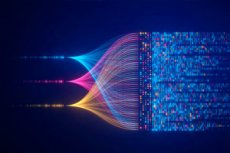
机器学习 (ML) 方法可以快速准确地诊断神经胶质瘤(原发性脑肿瘤)的突变。
卡尔·兰德斯坦纳医科大学(KL Krems)最近开展的一项研究证实了这一点。该研究利用机器学习方法分析了生理代谢磁共振成像(MRI)数据,以识别代谢基因的突变。该基因突变对疾病进程有显著影响,早期诊断对治疗至关重要。研究还表明,目前获取生理代谢MRI图像的标准并不一致,这阻碍了该方法在临床上的常规应用。
胶质瘤是最常见的原发性脑肿瘤。尽管其预后仍然不佳,但个性化治疗可以显著提高治疗成功率。然而,这种先进疗法的应用依赖于个体肿瘤数据,而由于胶质瘤位于脑部,获取这些数据非常困难。磁共振成像(MRI) 等成像方法可以提供此类数据,但其分析过程复杂、耗时且耗力。圣波尔滕大学医院(KL Krems 的教学和研究基地)的中央诊断医学放射学研究所多年来一直致力于开发机器学习和深度学习方法,以实现此类分析的自动化,并将其整合到常规临床程序中。如今,该研究所又取得了一项突破。
“携带异柠檬酸脱氢酶 (IDH) 基因突变的胶质瘤细胞患者的临床前景实际上比携带野生型的患者更好,”德国中央研究院医学物理学家 Andreas Stadlbauer 教授解释说。“这意味着我们越早了解突变状态,就越能制定个性化治疗方案。”突变型和野生型肿瘤的能量代谢差异有助于实现这一点。得益于 Stadlbauer 教授团队先前的研究,即使没有组织样本,也可以使用生理代谢磁共振成像 (MRI) 轻松测量这些差异。然而,分析和评估这些数据是一个非常复杂且耗时的过程,难以融入临床实践,尤其是在患者预后不佳、需要快速获得结果的情况下。
在当前的研究中,团队使用机器学习方法分析和解读这些数据,以便更快地获得结果并启动适当的治疗步骤。但结果的准确性如何?为了评估这一点,该研究首先使用了来自圣波尔滕大学医院的182名患者的数据,这些患者的MRI数据是按照标准化方案收集的。
施塔德鲍尔教授解释说:“当我们看到机器学习算法的结果时,我们非常满意。在区分基因野生型肿瘤和突变型肿瘤方面,我们的准确率达到了 91.7%,精确度达到了 87.5%。随后,我们将这些值与经典临床 MRI 数据的机器学习分析结果进行了比较,结果表明,以生理代谢 MRI 数据为基础,可以获得明显更好的结果。”
然而,这种优势仅在使用标准化协议分析圣珀尔滕收集的数据时才有效。当将机器学习方法应用于外部数据(即来自其他医院数据库的MRI数据)时,情况并非如此。在这种情况下,基于经典临床MRI数据训练的机器学习方法更为成功。
生理代谢MRI数据的机器学习分析结果较差的原因是,该技术尚处于发展初期,处于实验阶段。各医院的数据收集方法仍存在差异,这导致机器学习分析存在偏差。
对于科学家来说,标准化问题“仅仅”是其中之一,随着不同医院越来越多地使用生理代谢MRI,标准化问题将不可避免地出现。该方法本身——使用机器学习方法快速评估生理代谢MRI数据——已显示出优异的效果。因此,它是在术前确定胶质瘤患者IDH突变状态以及制定个体化治疗方案的绝佳方法。
研究结果发表在《卡尔·兰德斯坦纳健康科学大学(KL Krems)》杂志上。

